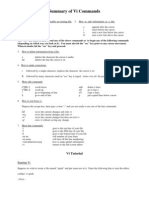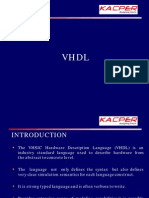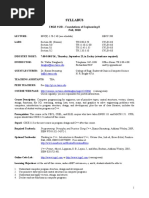Efficient Editing With Vim: Moving Efficiently
Efficient Editing With Vim: Moving Efficiently
Uploaded by
Ravi Krishna MalkaCopyright:
Available Formats
Efficient Editing With Vim: Moving Efficiently
Efficient Editing With Vim: Moving Efficiently
Uploaded by
Ravi Krishna MalkaOriginal Description:
Original Title
Copyright
Available Formats
Share this document
Did you find this document useful?
Is this content inappropriate?
Copyright:
Available Formats
Efficient Editing With Vim: Moving Efficiently
Efficient Editing With Vim: Moving Efficiently
Uploaded by
Ravi Krishna MalkaCopyright:
Available Formats
Efficient Editing With vim - Jonathan McPherson
http://jmcpherson.org/editing.html
Efficient Editing With vim
This article has been translated into French by Geoffrey Bachelet. You can read the French version here: L' dition efficace avec vim.
"To me, vi is Zen. To use vi is to practice zen. Every command is a koan. Profound to the user, unintelligible to the uninitiated. You discover truth every time you use it."
--reddy@lion.austin.com
This tutorial assumes a basic knowledge of vim -- insert mode, command mode, loading and saving files, etc. It is intended to help vi novices develop their skills so that they can use vi efficiently. In this tutorial, <C-X> means Ctrl-X -- that is, hold down the Ctrl key and press X. You can get help on most of the commands used here by typing :help command in vim, where command is what you need help on.
Moving efficiently
Stay out of insert mode
In general, you want to spend as little of your time in vim's insert mode as possible, because in that mode it acts like a dumb editor. This is why most vim novices spend so much time in insert mode -- it makes vim easy to use. But vim's real power lies in command mode! You'll find that the better you know vim, the less time you will spend in insert mode.
Use h, j, k, and l
The first step to efficient editing in vim is to wean yourself from the arrow keys. One of the the advantages of vim's modal design is that you do not need to constantly move your hands back and forth between the arrow keys and the letter keys; when you are in command mode, the letters h, j, k and l correspond to the directions left, down, up, and right, respectively. It takes some practice to get used to, but you will notice the speed difference once you're used to it. When you are editing e-mail or other paragraph-formatted text, you might notice that the direction keys skip more lines than you expect. This is because your paragraphs appear as one long line to vim. Type g before h, j, k or l to move by screen lines instead of virtual lines.
Use motions to move the cursor in the current line
Most editors have only simple commands for moving the cursor (left, up, right, down, to beginning/end of line, etc). vim has very advanced commands for moving the cursor; these commands are referred to as motions. When the cursor moves from one point in the text to another, the text between the points (and including the points themselves) is considered to be "moved over." (This will be important later.) Here are a few of the more useful motions:
1 of 6
26.10.2006 10:29
Efficient Editing With vim - Jonathan McPherson
http://jmcpherson.org/editing.html
fx Move the cursor forward to the next occurance of the character x on the current line (obviously, x can be any character you like). This is an extremely useful command. You can type ; to repeat the last f command you gave. tx Same as above, but moves the cursor to right before the character, not all the way to it. (It's very useful, really.) Fx Move the cursor backward to the next occurance of the character x on the current line. w Move the cursor forward by a word. b Move the cursor backward by a word. 0 Move the cursor to the beginning of the current line. ^ Move the cursor to the first character on the current line. $ Move the cursor to the end of the line ) Move the cursor forward to the next sentence. (Useful when editing e-mail or text documents.) ( Move the cursor backward by a sentence.
Move efficiently through the file
vim has many commands that can send you to where you want to go in your file -there's rarely a need to scroll manually through it. The below keystrokes are not technically motions, since they move around in the file instead of in a particular line.
<C-F> <C-B> G numG gg H M L *
Move the cursor forward by a screenful of text Move the cursor backward by a screenful of text Move the cursor to the end of the file Move the cursor line num. (For instance, 10G moves to line 10.) Move the cursor to the beginning of the file Move the cursor to the top of the screen. Move the cursor to the middle of the screen. Move the cursor to the bottom of the screen. Read the string under the cursor and go to the next place it appears. (For instance, if your cursor was somewhere on the word "bob," the cursor would move to the next occurance of "bob" in your file.) Same as above, except it moves the cursor to the previous occurance. # /text Starting from the cursor, find the next occurance of the string text and go to it. You will need to press Enter to execute the search. To re-execute your last search, type n (for next occurance). ?text Same as /, but searches in the opposite direction. Make a bookmark named a at the current cursor position. A bookmark can ma be named any lowercase letter. You can't see the bookmark, but it's there! Go to bookmark a. Important: that's a backtick, not a single quote. The `a backtick is located to the left of the 1 on most keyboards. Go to the line that you last edited. This is very useful! If you need to scroll `. through the file to look something up, you can go back to where you were without bookmarking it by using the `. command.
Typing efficiently
2 of 6 26.10.2006 10:29
Efficient Editing With vim - Jonathan McPherson
http://jmcpherson.org/editing.html
Use keyword completion
vim has a very nice keyword completion system. This means that you can type part of a long word, press a key, and have vim finish the word for you. For instance, if you have a variable called iAmALongAndAwkwardVarName somewhere in your code, you probably don't want to type the whole thing in every time you use it. To use keyword completion, just type the first few letters of the string (e.g. iAmAL) and press <C-N> (that means hold down Ctrl and type N) or <C-P>. If vim doesn't give you the word you want at first, keep trying -- vim will cycle through all completions it can find.
Enter insert mode intelligently
Most users new to vim get into insert mode by typing i. This works, but it's often pretty inefficient, since vi has a host of commands that leave the editor in insert mode. Here are some of the more popular ones:
i I a A o O c{motion}
Insert text to the left of the current character. Insert text at the beginning of the current line. Insert text to the right of the current character. Insert text at the end of the current line. Create a new line under the current one and insert text there. Create a new line above the current one and insert text there. Delete (change) the text moved over by {motion} and insert text to replace it. For instance, c$ would delete the text from the cursor to the end of the line and enter insert mode. ct! would delete the text from the cursor up to (but not including) the next exclamation mark and enter insert mode. The deleted text is copied to the clipboard and can be pasted. d{motion} Delete the text moved over by {motion} -- same as c{motion}, but doesn't enter insert mode.
Moving blocks of text efficiently
Use visual selections and the appropriate selection mode
Unlike the original vi, vim allows you to highlight text and perform operations on it. There are three main visual selection modes (that is, text highlighting modes). These modes are as follows:
Characterwise selection mode. This is the selection mode that most people are used to, so practice with it before trying the others. Linewise selection mode. Whole lines are always selected. This is better than V characterwise mode when you want to copy or move a group of lines. <C-V> Blockwise selection mode. Extremely powerful and available in very few other editors. You can select a rectangular block and any text inside that block will be highlighted. v
All the usual cusor movement keys apply -- so, for instance, vwww would go into visual selection mode and highlight the next three words. Vjj would go into linewise visual selection mode and highlight the current line and the two lines below it.
3 of 6
26.10.2006 10:29
Efficient Editing With vim - Jonathan McPherson
http://jmcpherson.org/editing.html
Cutting and copying from visual selections
Once you have a highlighted selection, you probably want to do something with it. Some of the more useful commands you can give when an area of text is highlighted:
d Cut (delete) the highlighted text and put it into the clipboard. y Copy (or yank, which is vim-ese for "copy") the highlighted text into the clipboard. c Cut the highlighted text into the clipboard. This is just like d, except it leaves the editor in insert mode.
Cutting and copying from non-visual selections
If you know exactly what you want to copy or cut, you can do it without entering visual mode. This saves time.
d{motion} Cut the text moved over by {motion} to the clipboard. For instance, dw would cut a word and dfS would cut from the cursor up to and including the next capital S on the current line of text. y{motion} Copy the text moved over by {motion}. c{motion} Cut the text moved over by {motion} and leave the editor in insert mode. Cut the current line. dd Copy the current line. yy Cut the current line and leave the editor in insert mode. cc Cut from the cursor to the end of the current line. D Yank the whole line, just like yy. (Yes, it's inconsistent! You can use y$ to Y do what you would expect Y to do.) Cut from the cursor to the end of the current line and leave the editor in C insert mode. Cut the current character. (This is sort of like a command-mode x backspace.) Cut the current character and leave the editor in insert mode. s
Pasting
Pasting is easy. Put the cursor where you want the pasted text and type p.
Using multiple clipboards
Most editors have a single clipboard. vim has many more; clipboards in vim are called registers. You can list all the currently defined registers and their contents by typing :reg. Typically, you'll be using the lowercase letter registers; the others are used for various internal vim purposes and are only occasionally helpful. To use a specific register for a copy or paste operation, simply type "a before the command for the operation, where a is the register you want to use. For example, to copy the current line into register k, you could type "kyy. (You could also type V"ky. Why would that work?). That line would stay in register k until you specifically copied something else into register k. You would then use "kp to paste the text from register k.
4 of 6
26.10.2006 10:29
Efficient Editing With vim - Jonathan McPherson
http://jmcpherson.org/editing.html
Avoiding repetition
The amazing . command
In vi, typing . (a period) will repeat the last command you gave. For instance, if your last command was dw (delete word), vi will delete another word.
Using counts
Counts are one of the most powerful and time-saving features of vim. Any command can be preceded by a number. The number will tell vim how many times to execute the command. Here are a few examples:
3j
will move the cursor down three lines. will delete ten lines.
10dd
will yank (copy) text from the cursor to the third quotation mark after the cursor on the current line. Counts are useful to extend the range of a motion in this manner.
y3"e;
Recording macros
Occasionally, you'll find yourself doing the same thing over and over to blocks of text in your document. vim will let you record an ad-hoc macro to perform the operation.
qregister Start macro recording into the named register. For instance, qa starts recording and puts the macro into register a. End recording. q @register Replay the macro stored in the named register. For instance, @a replays the macro in register a.
Keep in mind that macros just record your keystrokes and play them back; they are not magic. Recording macros is almost an art form because there are so many commands that accomplish a given task in vim, and you must carefully select the commands you use while your macro is recording so that they will work in all the places you plan to execute the macro.
Writing code in vim
vim is an excellent editor for source code because it has many features that are specifically designed to help programmers. Here are a few of the more handy ones:
]p Just like p, but it automatically adjusts the indent level of the pasted code to match that of the code you paste into. Try it! % Putting the cursor on a brace, bracket, or parenthese and pressing % will send the cursor to the matching brace, bracket, or parenthese. Great for fixing parse problems related to heavily nested blocks of code or logic. >> Indent the highlighted code. (See the earlier section about efficient text selection. If no text is selected, the current line is indented.) << Like >>, but un-indents. gd Go to the definition (or declaration) of the function or variable under the cursor.
5 of 6
26.10.2006 10:29
Efficient Editing With vim - Jonathan McPherson
http://jmcpherson.org/editing.html
K Go to the man page for the word currently under the cursor. (For instance, if your cursor is currently over the word sleep, you will see the man page for sleep displayed.)
DESIGN AND CONTENT 2003 J. McPherson UNLESS NOTED OTHERWISE. LAST DML REBUILD (UPDATE): June 10 2006 09:43 AM SEE CONTACT INFO. This page is valid XHTML 1.0 Strict.
6 of 6
26.10.2006 10:29
Splits and multi-file editing - Jonathan McPherson
http://jmcpherson.org/windows.html
Splits and multi-file editing
Perhaps one of the most limiting features of the original vi is its inability to edit more than one file at once. vim removes this limitation; it can edit many files at the same time. In typical vim fashion, it provides many ways to do this. I'll focus on the easiest way to visualize, which uses "splits," which are like independent windows that can each contain a text file.
Opening a file in a split
Assuming you are already editing a file in a vim session and want to split the screen and edit a second file, you can use either of these commands:
:sp filename Splits the screen horizontally and opens filename in the new area. :vsp filename Splits the screen vertically and opens filename in the new area.
For most purposes, horizontal splits are easier to manage. Any split can be further split -- you can edit as many files in a single instance of vim as you like.
Managing splits
Once you are editing multiple files, you will probably need to move back and forth through your files and manage the size of the splits so that you can see the relevant portions of the files you're interested in. The prefix for all the below commands is <C-W> -- that is, hold down Ctrl and type w. Press <C-W> before typing any of the below commands.
<C-W> Moves to the next split. Moves to the split above the current split. k Moves to the split above the current split. Up Moves to the split below the current split. j Down Moves to the split below the current split. Increases the size of the current split by one line. (Try combining this with + counts -- e.g. 5<C-W>+ will make the split five lines bigger.) (Minus sign) Decreases the size of the current split by one line. (Underscore) Maximize the current split (that is, make it take up as much _ room as possible.)
Saving and quitting
Each split acts something like an individual instance of vim -- so :w and :q work on the current split. If you want those commands to apply to all the splits instead of just the current one, add a to them -- for instance, :wa saves all the open files, :qa quits all open files (and exits vim), and :wqa saves and then closes all open files.
Recommended mappings
I recommend adding the below files to your .vimrc file to make working with splits easier:
1 of 2
26.10.2006 10:30
Splits and multi-file editing - Jonathan McPherson
http://jmcpherson.org/windows.html
map <C-J> <C-W>j<C-W>_ map <C-K> <C-W>k<C-W>_ set wmh = 0
The first two lines allow you to switch between splits much more smoothly -- just press <C-J> to open and maximize the split below the current one and <C-K> to open and maximize the split above the current one. I chose these mappings because they correspond to vi's default up and down keys, you might want to use different key combinations if you've ever used an editor that had hotkeys for moving from one open file to another. The last line allows splits to reduce their size to a single line (which includes the filename and position); this saves a lot of space when you have many splits open. By default, vim forces splits to include an additional line that contains the line of text the cursor was on in that file.
DESIGN AND CONTENT 2003 J. McPherson UNLESS NOTED OTHERWISE. LAST DML REBUILD (UPDATE): June 10 2006 09:43 AM SEE CONTACT INFO. This page is valid XHTML 1.0 Strict.
2 of 2
26.10.2006 10:30
.vimrc and customization - Jonathan McPherson
http://jmcpherson.org/vimrc.html
.vimrc and customization
vim is extremely customizable. It will read the file .vimrc in your home directory before it starts. This file can contain settings and even scripts. The below settings are ones I've found helpful -- give them a try!
set nocompatible
This setting prevents vim from emulating the original vi's bugs and limitations.
set autoindent set smartindent
The first setting tells vim to use "autoindent" (that is, use the current line's indent level to set the indent level of new lines). The second makes vim attempt to intelligently guess the indent level of any new line based on the previous line, assuming the source file is in a C-like language. Combined, they are very useful in writing well-formatted source code.
set tabstop=4 set shiftwidth=4
I prefer 4-space tabs to 8-space tabs. The first setting sets up 4-space tabs, and the second tells vi to use 4 spaces when text is indented (auto or with the manual indent adjustmenters.)
set showmatch
This setting will cause the cursor to very briefly jump to a brace/parenthese/bracket's "match" whenever you type a closing or opening brace/parenthese/bracket. I've had almost no mismatched-punctuation errors since I started using this setting.
set guioptions-=T
I find the toolbar in the GUI version of vim (gvim) to be somewhat useless visual clutter. This option gets rid of the toolbar.
set vb t_vb=
This setting prevents vi from making its annoying beeps when a command doesn't work. Instead, it briefly flashes the screen -- much less annoying.
set ruler
This setting ensures that each window contains a statusline that displays the current cursor position.
set nohls
By default, search matches are highlighted. I find this annoying most of the time. This option turns off search highlighting. You can always turn it back on with :set hls.
set incsearch
With this nifty option, vim will search for text as you enter it. For instance, if you type /bob to search for bob, vi will go to the first "b" after you type the "b,"
1 of 2
26.10.2006 10:32
.vimrc and customization - Jonathan McPherson
http://jmcpherson.org/vimrc.html
to the first "bo" after you type the "o," and so on. It makes searching much faster, since if you pay attention you never have to enter more than the minimum number of characters to find your target location. Make sure that you press Enter to accept the match after vim finds the location you want.
set virtualedit=all
By default, vim doesn't let the cursor stray beyond the defined text. This setting allows the cursor to freely roam anywhere it likes in command mode. It feels weird at first but is quite useful. Type :help options within vim to get a complete list of options. Many more advanced techniques, options, and mappings are available on the official vim site.
DESIGN AND CONTENT 2003 J. McPherson UNLESS NOTED OTHERWISE. LAST DML REBUILD (UPDATE): June 10 2006 09:43 AM SEE CONTACT INFO. This page is valid XHTML 1.0 Strict.
2 of 2
26.10.2006 10:32
You might also like
- FinancialForce Licensing Guide Subscription OverviewNo ratings yetFinancialForce Licensing Guide Subscription Overview44 pages
- Shell Scripting: Getting Started With Shell ProgrammingNo ratings yetShell Scripting: Getting Started With Shell Programming14 pages
- Nano VI Emacs VI VI (File) Vim (File) VI View (File) Vim ViewNo ratings yetNano VI Emacs VI VI (File) Vim (File) VI View (File) Vim View4 pages
- Unix - The VI Editor Tutorial: Command Description VI Filename VI - R Filename View FilenameNo ratings yetUnix - The VI Editor Tutorial: Command Description VI Filename VI - R Filename View Filename8 pages
- 1 Introduction and Getting Started: The Vi EditorNo ratings yet1 Introduction and Getting Started: The Vi Editor3 pages
- Inserting, Changing, Replacing, and Joining: GoalNo ratings yetInserting, Changing, Replacing, and Joining: Goal6 pages
- The VI Editor: Behr@math - Niu.edu First Draft: February 1994 Last Revision: May 1995No ratings yetThe VI Editor: Behr@math - Niu.edu First Draft: February 1994 Last Revision: May 19957 pages
- A VI Primer: VI Is A Simple, Visual Editor. It Is Very Fast, Easy To Use, and Available On Virtually Every UNIXNo ratings yetA VI Primer: VI Is A Simple, Visual Editor. It Is Very Fast, Easy To Use, and Available On Virtually Every UNIX13 pages
- Practical No:-4: Aim: - Familiarize With Vi' Editor and Linux GuisNo ratings yetPractical No:-4: Aim: - Familiarize With Vi' Editor and Linux Guis3 pages
- Unix Text Editors: vs. Battle To The Death Coming Soon On Pay-Per-ViewNo ratings yetUnix Text Editors: vs. Battle To The Death Coming Soon On Pay-Per-View20 pages
- Introduction To UNIX: Lecture Six: 6.1 ObjectivesNo ratings yetIntroduction To UNIX: Lecture Six: 6.1 Objectives8 pages
- Editors (Vim) : Strong Opinions Stack Overflow Survey Visual Studio Code VimNo ratings yetEditors (Vim) : Strong Opinions Stack Overflow Survey Visual Studio Code Vim9 pages
- Become A Vi Master by Learning These 30+ Key BindingsNo ratings yetBecome A Vi Master by Learning These 30+ Key Bindings9 pages
- Low-Power Ic Design: Outline: System-On-Chip Design (For Es)No ratings yetLow-Power Ic Design: Outline: System-On-Chip Design (For Es)17 pages
- High-Performance and Low-Power Clock Network Synthesis in The Presence of VariationNo ratings yetHigh-Performance and Low-Power Clock Network Synthesis in The Presence of Variation174 pages
- Automatic Clock Gating For Power ReductionlNo ratings yetAutomatic Clock Gating For Power Reductionl11 pages
- Ebook 110 Accounting Interview Questions Answers100% (1)Ebook 110 Accounting Interview Questions Answers54 pages
- A, All, Am, An, And, Any, Are, As, Ask, At, Ate, Away, Be, Big, But, Buy, By, For, Do, Did, Can, Go, Has, Had, Is, Was, Me, My, Of, So, orNo ratings yetA, All, Am, An, And, Any, Are, As, Ask, At, Ate, Away, Be, Big, But, Buy, By, For, Do, Did, Can, Go, Has, Had, Is, Was, Me, My, Of, So, or2 pages
- Memory Interfaces: Support Logic For Memory Modules and Other Memory SubsystemsNo ratings yetMemory Interfaces: Support Logic For Memory Modules and Other Memory Subsystems16 pages
- Awk Is One of The Most Powerful Utilities Used in The Unix World. Whenever It Comes To Text ParsingNo ratings yetAwk Is One of The Most Powerful Utilities Used in The Unix World. Whenever It Comes To Text Parsing5 pages
- Awk Is One of The Most Powerful Utilities Used in The Unix World. Whenever It Comes To Text ParsingNo ratings yetAwk Is One of The Most Powerful Utilities Used in The Unix World. Whenever It Comes To Text Parsing5 pages
- L03 - C Shell Scripting - Part 1 1. What Is A Shell?: Shell Command-Line InterpreterNo ratings yetL03 - C Shell Scripting - Part 1 1. What Is A Shell?: Shell Command-Line Interpreter8 pages
- Conexión y Programación Vista 32FB y 128FBPNo ratings yetConexión y Programación Vista 32FB y 128FBP2 pages
- Concurrent Process and Programming: Processs and Threads ProcessesNo ratings yetConcurrent Process and Programming: Processs and Threads Processes11 pages
- The Design Process: Prepared by MDM PytanNo ratings yetThe Design Process: Prepared by MDM Pytan131 pages
- Fill in The Blanks On Introduction To Computers - Loksewa ExamNo ratings yetFill in The Blanks On Introduction To Computers - Loksewa Exam2 pages
- Liventus_Application Developer (Entry Level)_55No ratings yetLiventus_Application Developer (Entry Level)_552 pages
- Rational: Automate A Manual Test That Is Based On KeywordsNo ratings yetRational: Automate A Manual Test That Is Based On Keywords17 pages
- Database - Oracle Database 12c R2 - Administration Workshop Ed 3 - Oracle UniversityNo ratings yetDatabase - Oracle Database 12c R2 - Administration Workshop Ed 3 - Oracle University6 pages
- FinancialForce Licensing Guide Subscription OverviewFinancialForce Licensing Guide Subscription Overview
- Shell Scripting: Getting Started With Shell ProgrammingShell Scripting: Getting Started With Shell Programming
- Nano VI Emacs VI VI (File) Vim (File) VI View (File) Vim ViewNano VI Emacs VI VI (File) Vim (File) VI View (File) Vim View
- Unix - The VI Editor Tutorial: Command Description VI Filename VI - R Filename View FilenameUnix - The VI Editor Tutorial: Command Description VI Filename VI - R Filename View Filename
- The VI Editor: Behr@math - Niu.edu First Draft: February 1994 Last Revision: May 1995The VI Editor: Behr@math - Niu.edu First Draft: February 1994 Last Revision: May 1995
- A VI Primer: VI Is A Simple, Visual Editor. It Is Very Fast, Easy To Use, and Available On Virtually Every UNIXA VI Primer: VI Is A Simple, Visual Editor. It Is Very Fast, Easy To Use, and Available On Virtually Every UNIX
- Practical No:-4: Aim: - Familiarize With Vi' Editor and Linux GuisPractical No:-4: Aim: - Familiarize With Vi' Editor and Linux Guis
- Unix Text Editors: vs. Battle To The Death Coming Soon On Pay-Per-ViewUnix Text Editors: vs. Battle To The Death Coming Soon On Pay-Per-View
- Editors (Vim) : Strong Opinions Stack Overflow Survey Visual Studio Code VimEditors (Vim) : Strong Opinions Stack Overflow Survey Visual Studio Code Vim
- Become A Vi Master by Learning These 30+ Key BindingsBecome A Vi Master by Learning These 30+ Key Bindings
- Low-Power Ic Design: Outline: System-On-Chip Design (For Es)Low-Power Ic Design: Outline: System-On-Chip Design (For Es)
- High-Performance and Low-Power Clock Network Synthesis in The Presence of VariationHigh-Performance and Low-Power Clock Network Synthesis in The Presence of Variation
- A, All, Am, An, And, Any, Are, As, Ask, At, Ate, Away, Be, Big, But, Buy, By, For, Do, Did, Can, Go, Has, Had, Is, Was, Me, My, Of, So, orA, All, Am, An, And, Any, Are, As, Ask, At, Ate, Away, Be, Big, But, Buy, By, For, Do, Did, Can, Go, Has, Had, Is, Was, Me, My, Of, So, or
- Memory Interfaces: Support Logic For Memory Modules and Other Memory SubsystemsMemory Interfaces: Support Logic For Memory Modules and Other Memory Subsystems
- Awk Is One of The Most Powerful Utilities Used in The Unix World. Whenever It Comes To Text ParsingAwk Is One of The Most Powerful Utilities Used in The Unix World. Whenever It Comes To Text Parsing
- Awk Is One of The Most Powerful Utilities Used in The Unix World. Whenever It Comes To Text ParsingAwk Is One of The Most Powerful Utilities Used in The Unix World. Whenever It Comes To Text Parsing
- L03 - C Shell Scripting - Part 1 1. What Is A Shell?: Shell Command-Line InterpreterL03 - C Shell Scripting - Part 1 1. What Is A Shell?: Shell Command-Line Interpreter
- Concurrent Process and Programming: Processs and Threads ProcessesConcurrent Process and Programming: Processs and Threads Processes
- Fill in The Blanks On Introduction To Computers - Loksewa ExamFill in The Blanks On Introduction To Computers - Loksewa Exam
- Rational: Automate A Manual Test That Is Based On KeywordsRational: Automate A Manual Test That Is Based On Keywords
- Database - Oracle Database 12c R2 - Administration Workshop Ed 3 - Oracle UniversityDatabase - Oracle Database 12c R2 - Administration Workshop Ed 3 - Oracle University









































































































